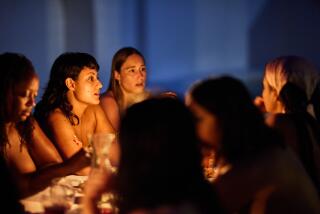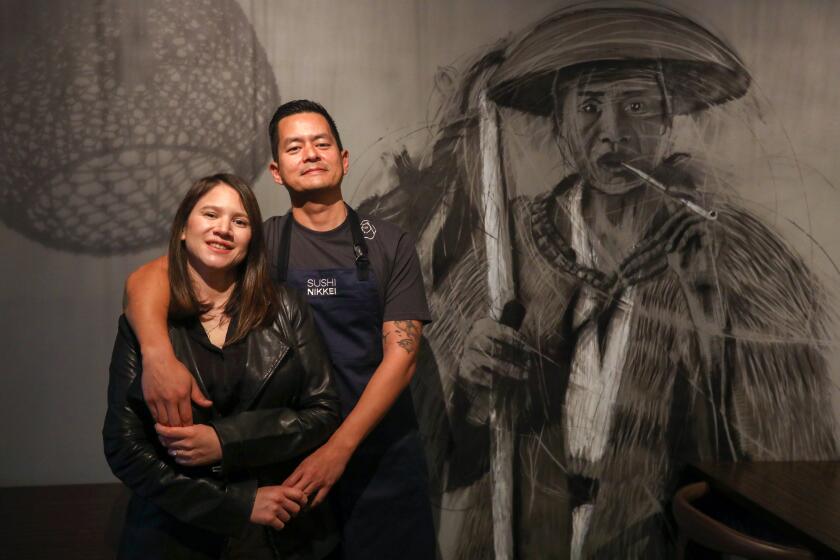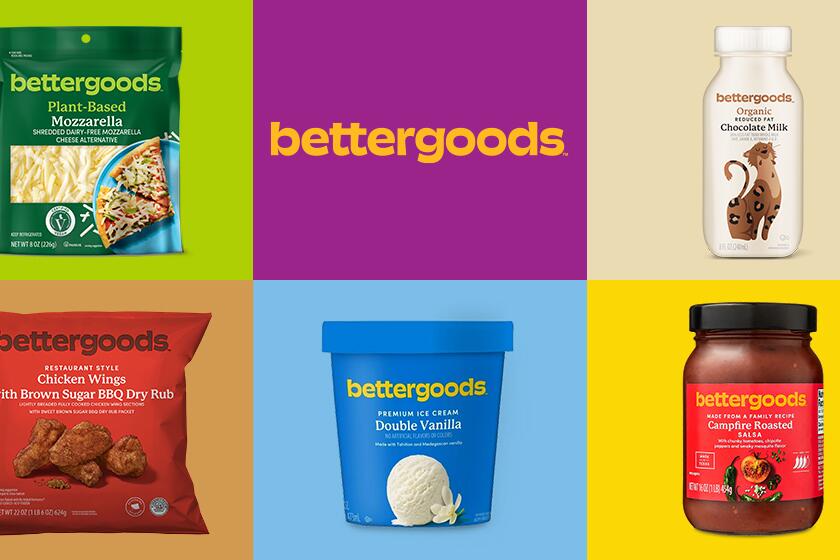Loire wines: So much to love
WHEN sommeliers speak of wines from the Loire Valley, a funny thing happens to their tone of voice. It gets softer, more tender, as if they’re not talking about wine anymore, but maybe showing you pictures of their children.
“I love each one of them for slightly different reasons,” says Lou Amdur of Lou, the wine bar on Vine Street.
“They’re my little wines,” says Shawn Mead, former wine director at Campagne in Seattle. “I love their immediacy, their complete lack of airs; it’s not that they lack complexity, but there’s less of a sense of seriousness that surrounds them. It’s more liberating than drinking a Bordeaux and all that formality.”
Perhaps that’s why all bistro, bar and cafe chalkboards in Paris list Loire Valley wines in overwhelming numbers. Racy Muscadets, Sancerres, Pouilly-Fumes, rich Vouvrays, earthy Chinons -- they’re the everyday wines of France. Not, typically, trophies nor wines to contemplate or brood over, they’re part of the fabric of daily life.
“Loire wines feel familiar, like going back to your favorite old neighborhood,” says Wilshire restaurant’s wine director Matt Straus. “They’re one of the last great bastions of affordable Old-World quality.”
Partly this is because in a single valley you have an unparalleled spectrum of flavors and textures, nearly the complete palette of all that wine can produce, from bright, clean and green to deep, dark and concentrated.
But the real reason that Paris and nearly every sommelier in town loves the Loire is because these wines are tailor-made to pair with food. And their lightness of touch, their modest alcohols and gentle tannins make them ideal wines for summer meals.
The valley forged by the Loire -- France’s largest river -- covers a swath from the Massif Central (an elevated volcanic shelf that pretty much comprises Central France) south of Paris to the sea, coursing across a vast array of French geology, through marine sediments, alluviums, slates, schists, sands, sandstones, river stones, limestone, tufa, and combinations therein.
The geological wonderland quality of the place amounts to an important calling card for Loire wines in general: their minerality. Whether it’s a bracing Muscadet white from the coast or a smoky Chinon red from the Touraine, all possess an impressive mineral backbone.
Whites dominate the wines of the Loire, and a great majority come from vineyards in and around the city of Nantes, near the country’s western shores. These are planted to a grape called Melon de Bourgogne -- a variety that bears some resemblance to Pinot Blanc and Sauvignon -- and made into Muscadet. These inexpensive, bracing whites are known for their minerality, acidity and nerve, as well as a clean, arresting neutrality, serving as a lens for the food one pairs it with -- which more often than not is seafood.
The best Muscadet comes from an appellation called Sevre et Maine, where the slightly warmer inland climate makes for a more characterful wine. Muscadet has long been considered the ideal pairing with oysters precisely because both the food and the wine share a subtle saline, limey quality -- the same could be said for roast clams, and even a mild ceviche.
Most Muscadet imported to this country is simple and delicious, and a few domaines, like Joseph Landron’s Domaine de la Louvetrie and Marc Ollivier’s Domaine de la Pepiere, have especially pristine renderings from old, organically tended vines.
Charms of Loire wines
THE Loire wines best known in this country are made with Sauvignon Blanc, namely Sancerre and Pouilly-Fume. These two appellations produce Sauvignons of extraordinary vitality, and lately, with a string of warm vintages, an additional starburst of fruit that adds to their charms.
Sancerres and Pouilly-Fumes are grown on subtly different soils, leading to subtly different shades of vibrancy. Sancerre is a village surrounded by soils high in limestone and giving off a chalky minerality (the reds from Sancerre, made from Pinot Noir and well worth seeking out, have a similar edge). Pouilly-Fume is just across the river near the village of Pouilly-sur-Loire, where the soils are additionally flecked with flint, which tends to impart a slatey, slightly smoky perfume -- hence the term fume.
Pouilly is home to one of the Loire’s best-known winemakers, Didier Dagueneau. His basic cuvee, called “En Chailloux,” is classic Pouilly, but wines like his stylish “Silex” add barrel fermentation and a creamy oak note.
Sancerre tends to be more popular, usually unadorned by oak, and more reasonably priced. Look for classics, like those of Lucien Crochet, Sylvain Bailly and Paul Cotat. Recently I came upon a stunningly vibrant 2005 by a producer named Paul Thomas, from Chavignol. Pairing it with the goat cheeses from that village would work wonderfully, as would matching it with California offerings such as Laura Chenel or Humboldt Fog. Sancerre’s rippling natural acidity cuts right through the chalky richness of the cheese, cleaning the palate for the next bite.
Where Muscadet may be thought of as one well-played note in the key of shellfish, Sauvignons can enliven nearly any seafood dish they come near. In Paris bistros they typically accompany poached fish dishes like quenelles de brochet -- pike, poached in cream and white wine. In Los Angeles, it can work with just about any seafood, from prawns and scallops to any meaty grilled fish, especially when it’s adorned with light, fresh herbs such as chervil and tarragon.
The Loire Valley’s Chenin Blanc is a grape that’s grown almost nowhere else in France and is unquestionably one of the country’s most overlooked varieties. Few wines are as complex or long-lived, and only Riesling shares its capacity for transparency, complexity and chameleonic variation.
Dry Chenins display razor-sharp acids; riper versions are among the richest, most unctuous and sumptuous wines you’ll ever put in your mouth. They also age remarkably; currently, Wilshire’s Straus is pouring a 1994 Chenin from Roches aux Moines in Savennieres that’s as fresh and summery at 12 years of age as most whites are at 12 months.
The appellation that seems to embody this dramatic range is Vouvray, a village in the Touraine with soils that are a mixture of clay and limestone. Look for the wines of Champalou, Foreau, and especially Huet, whose exceptional wines seem to cover the gamut of styles, from bone dry to rich dessert. Just across the river from Vouvray is Montlouis, a region for Chenin that’s not as well known but is home to certain winemakers who make extraordinary wines, notably Francois Chidaine.
A wine for every dish
CHENIN’S incredible range of flavors means that there’s probably one for just about every dish on Earth this side of red meat -- you could find a Chenin pairing with enough sweetness to play to rich, fleshy smoked fish or gravlax.
West of Vouvray is Savennieres, where one of the world’s oldest vineyards is tended by one of the world’s most iconoclastic and influential winemakers. The winemaker is Nicolas Joly, a vociferous proselytizer for biodynamic farming. Partly as a result of Joly’s efforts, the Loire may lead the world in the number of practitioners of this esoteric, hyper-organic farming practice.
Joly’s family also owns and farms the Coulee de Serrant vineyard, a schist-studded slope on the banks of the Loire where vines have been tended for nearly 800 years. The white wines of Savennieres are usually drier and more savory than the wines of the Touraine, again with extraordinary aging potential and a haunting minerality that expresses itself often with notes of mushroom, earth, and truffle -- giving you a pretty good indication of what to serve with it.
There are three principle red grape varieties used in the Loire, but Cabernet Franc is the region’s most prominent (Pinot and Gamay Noir are grown here too in small quantities). Of course, Cabernet Franc is an important blending component in Bordeaux, especially on the Right Bank, where it can ripen to a sappy, red-fruited pliancy.
Cabernet Franc from the Loire seems more versatile with food than perhaps any other red wine; it can go deeper than Pinot Noir and is considerably more nimble than French (and certainly American) Syrah or Grenache, and is lighter and more supple than Merlot. You’ll also have a hard time spending more than $30 on a bottle.
In the much cooler Loire regions of Chinon, Saumur-Champigny, and Bourgueil, Cabernet Franc is lighter bodied, with more herbaceous, earthy notes, and a lightly smoked quality that makes it a natural with olives and tapenades. It also pairs terrifically with the middle register of meats, such as pork chops and duck breast. If the duck is accompanied by lentils, so much the better: The finest lentils in France are grown east of Chinon in Berry, and their earthiness makes for a fine pairing with Loire reds.
Of the three most prominent Cab Franc regions, Chinon is probably the best known. Chinon wines have a smoky fragrance and a gripping, rustic texture, such as you’ll find in the wines of Charles Joguet and Olga Raffault. Bourgueil tends to possess generally softer tannins, but with more of a mineral tang than Chinon -- Catherine and Pierre Breton make a number of the region’s finest, but I recently found beautifully soft and smoky ’03 from Domaine du Bel Air, to pair beautifully with grilled pork loin, say, or even ham.
The wines of Saumur-Champigny may be the most elegant of the three Cab Franc regions, with a silky texture, rich and smoky, almost cocoa scents, and slightly less herbal flavors than their counterparts.
The best thing about Loire wines is that they don’t require a lot of forethought or contemplation, making them ideal for summer. There are so many affordable options that they fit beautifully into daily life. And like your children, you may never tire of talking about them.
*
Fruits and flowers
2005 Marc Ollivier Muscadet Sevre et Maine “Clos des Briords.” Impressive minerality, even in its aromas, with hints of white pepper, rose petal and lime. Displays a neutral density, saline, minerals, and a bright, key-lime citrus flavor. Brief but emphatic finish. Available at Manhattan Fine Wines in Manhattan Beach, (310) 374-3454, about $12.
2005 Paul Thomas Sancerre Chavignol “Les Comtesses.” A Sauvignon of exceptional grace, bearing the generous fruit of a warm vintage without excess. It has aromas of gooseberries and an herbal, almost tarragon note. Ample ripe apple flavors are tightened up by a touch of citrus, the experience of the fruit together showing a beautiful purity. For something pure and simple, like grilled calamari with lemon. Available at John and Pete’s Fine Wines & Spirits in West Hollywood, (310) 657-3080; and Red Carpet Wine Merchants in Glendale, (800) 339-0609, about $19.
2002 Domaine des Baumard Savennieres. Rich and dry at once, this Chenin Blanc gives off aromas of peach, lime oil and wet stones. The flavors are savory, with hints of peach and ripe pear giving way to an almost floral note on the finish. Its acidity and talc-like minerality cut into the soft pear fruit leaving behind a finish of green herb. Substantial enough for roast chicken. Available at the Wine Exchange in Orange, (714) 974-1454 and (800) 76WINEX, about $32; and the Wine Club in Santa Ana, (714) 835-6485, half-bottles about $11.
2004 Champalou Vouvray Sec. A clean Chenin Blanc with a fair amount of residual sugar, this wine manages to stay pretty racy and bright, with a grapey green apple aroma and a nice grainy texture to complement the sweet and lush apple flavors. It has plenty of acidity for a crisp finish; a good pairing with mild goat cheeses. Available at Red Carpet Wine Merchants, about $13.
2004 Gaston Huet Vouvray Sec “Le Haut Lieu.” This youthful dry Chenin has an ethereal aroma of apple blossoms and dried pear, even a saline scent; in the glass it’s elegant and exquisitely balanced, leading with complex pear and herbal flavors and rippling acidity. At Wine House in Los Angeles, (310) 479-3731; and Woodland Hills Wine Co. in Woodland Hills, (818) 222-1111, about $25.
2003 Francois Chidaine Montlouis sur Loire “Les Tuffeaux.” A stunning Chenin from a biodynamic producer in Montlouis and Vouvray, this is a wine of exceptional richness, viscosity and intensity with a golden color, rich golden apple scents with undertones of ripe peach. Almost unheard of opulence from Montlouis. Available at Mission Wines in South Pasadena, (626) 403-9463, about $22.
2003 Domaine du Bel Air Bourgueil, “les Vingt lieux dits.” Classic Bourgueil with scents like a small fire made with herbs, thyme branches, olive leaves, green peppercorn. The flavors of a plum compote, stewed with green herbs and peppercorn, with a soft prickle of minerality on the finish. Silky texture, soft. Serve with something lightly smoky off the grill, like pork loin. Available at Hi-Time Wine Cellars in Costa Mesa, (949) 650-8463, about $16.
2003 Charles Joguet Chinon “Les Varennes du Grand Clos.” A generous perfume of violets, bergamot and oolong tea. The fruit component shows up on the palate, with a pretty strawberry/red cherry flavor rendered exotic by clean, mildly herbal tannins. A delicate wine from a not-so-delicate vintage. Serve with grilled salmon on a bed of green lentils. Available at Wine House, about $24.
-- Patrick Comiskey
More to Read
Eat your way across L.A.
Get our weekly Tasting Notes newsletter for reviews, news and more.
You may occasionally receive promotional content from the Los Angeles Times.






